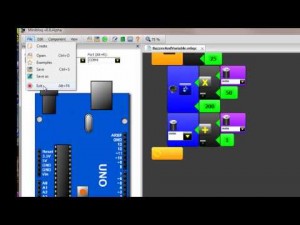It been a while since I wrote about Minibloq Graphical programming Environment for Arduino but a lot has changed since my last post. Minibloq has been rapidly gaining support from many channels. New hardware and software alliances have cropped up to make the program more robust.
Sparkfun, a major supplier of electronic projects for the maker community has introduced a starter package designed specifically for use with Minibloq Graphical Programming Environment. The Minibloq & Sparkfun Inventors kit for Arduino is the first offering in support of the language. Sparkfun has packaged an Arduino Uno along with a specially designed tray which holds the arduino and a breadboard securely. The package includes a series of projects which neophyte Arduino hackers can work on to increase their knowledge. The package also includes enough electronics, motors and sensors to build 12 projects. In addition The Sparkfun Inventors Kit includes a 36 page manual (a free pdf download) and 12 plastic coated circuit cards.
New tutorial files have begun appearing for Minibloq already. But now Minibloq tutorials are being translated into many different languages. A Dutch, Spanish and an English version of the tutoraials have been released so far. Plans for other languages are in progress.
Additionally, a Users Manual for Minibloq is now available in both English and Spanish. The English version is only available online but the Spanish version is available as a PDF document. http://blog.minibloq.org/p/documentation.html. The Spanish translation was created by Robotgroup a company which focuses on robots in education, robotic research and the manufacture of robots.
New features are constantly being added to Minibloq. The latest features include USB HID integration, and additional sensor module support. Several new programming blocks have also been added including a new for sending text to the screen through a serial port.
Minibloq has also partnered with Frizing Diagrams software. Fritzing is an open-source initiative to support designers, artists, researchers and hobbyists to work creatively with interactive electronics. Fritzing allows users to document their prototypes, share them with others, teach electronics in a classroom, and to create a pcb layout for professional manufacturing. Now the Minibloq tutorials also include Fritzing diagrams to illustrate the actual circuits created for the Arduino programs. The addition of the Fritzing diagrams to the tutorials really takes the quality up a notch.
A recent trip to China by the program developer Julian da Silva may forge new alliances with companies like Seedstudio and DfRobot. Minibloq was well received by a standing room only crowd at he University of Nanchang. Minibloq growing popularity around the world is just one more reason why Minibloq Graphical Programming Environment for Arduino is rapidly gaining support in the maker community.
Minibloq Graphical Programming Environment for Arduino is an open source project originally started as a Kickstarter project. Minibloq was successfully funded in under two weeks of it’s launch, raising over $8000 in backing. If you woul like to see more information on Minibloq check out these articles.
Minibloq Info:
Minibloq-making-arduino-easier-to-program
How I programmed an Arduino without writing code.
Minibloq is coming to ipad Minibloq4ipad
Minibloq-v0-8-alphas-new-features
Miniblog-beta-supports-arduino-and-maple-32-microcontrollers
Minibloq-beta-adds-support-for-arduino-mega-boards

